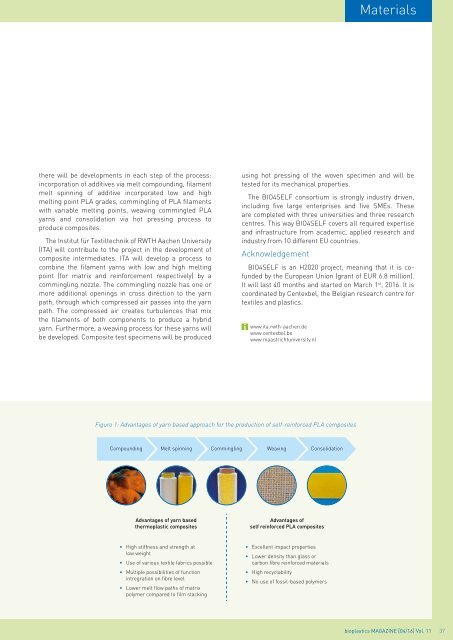Issue 04/2016
bioplasticsMAGAZINE_1604
bioplasticsMAGAZINE_1604
You also want an ePaper? Increase the reach of your titles
YUMPU automatically turns print PDFs into web optimized ePapers that Google loves.
Materials<br />
there will be developments in each step of the process:<br />
incorporation of additives via melt compounding, filament<br />
melt spinning of additive incorporated low and high<br />
melting point PLA grades, commingling of PLA filaments<br />
with variable melting points, weaving commingled PLA<br />
yarns and consolidation via hot pressing process to<br />
produce composites.<br />
The Institut für Textiltechnik of RWTH Aachen University<br />
(ITA) will contribute to the project in the development of<br />
composite intermediates. ITA will develop a process to<br />
combine the filament yarns with low and high melting<br />
point (for matrix and reinforcement respectively) by a<br />
commingling nozzle. The commingling nozzle has one or<br />
more additional openings in cross direction to the yarn<br />
path, through which compressed air passes into the yarn<br />
path. The compressed air creates turbulences that mix<br />
the filaments of both components to produce a hybrid<br />
yarn. Furthermore, a weaving process for these yarns will<br />
be developed. Composite test specimens will be produced<br />
using hot pressing of the woven specimen and will be<br />
tested for its mechanical properties.<br />
The BIO4SELF consortium is strongly industry driven,<br />
including five large enterprises and five SMEs. These<br />
are completed with three universities and three research<br />
centres. This way BIO4SELF covers all required expertise<br />
and infrastructure from academic, applied research and<br />
industry from 10 different EU countries.<br />
Acknowledgement<br />
BIO4SELF is an H2020 project, meaning that it is cofunded<br />
by the European Union (grant of EUR 6.8 million).<br />
It will last 40 months and started on March 1 st , <strong>2016</strong>. It is<br />
coordinated by Centexbel, the Belgian research centre for<br />
textiles and plastics.<br />
www.ita.rwth-aachen.de<br />
www.centexbel.be<br />
www.maastrichtuniversity.nl<br />
Figure 1: Advantages of yarn based approach for the production of self-reinforced PLA composites<br />
Compounding Melt spinning Commingling Weaving Consolidation<br />
Advantages of yarn based<br />
thermoplastic composites<br />
Advantages of<br />
self reinforced PLA composites<br />
• High stiffness and strength at<br />
low weight<br />
• Use of various textile fabrics possible<br />
• Multiple possibilities of function<br />
intregration on fibre level<br />
• Lower melt flow paths of matrix<br />
polymer compared to film stacking<br />
• Excellent impact properties<br />
• Lower density than glass or<br />
carbon fibre reinforced materials<br />
• High recyclability<br />
• No use of fossil-based polymers<br />
bioplastics MAGAZINE [<strong>04</strong>/16] Vol. 11 37


















